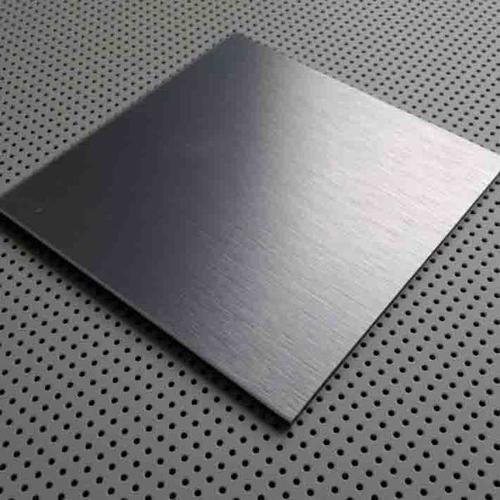What are the types of stainless steel plate?
Stainless steel is often divided into: martensitic steel, ferrite steel, austenitic steel, etc. In addition, it can be divided into chromium stainless steel, chromium nickel stainless steel and chromium manganese nitrogen stainless steel.
1. Ferritic stainless steel: 12-30% chromium. Its corrosion resistance, resistance and weldability are improved with the addition of chromium content, and its chloride stress corrosion resistance is better than that of other stainless steels. Crl7, cr17mo2ti, Cr25, cr25mo3ti and Cr28 belong to this category. Because of its high chromium content, ferritic stainless steel has good corrosion resistance and oxidation resistance, but poor mechanical and technological functions. It is mainly used in acid resistant structure with little stress and as anti-oxidation steel. This kind of steel can resist the corrosion of atmosphere and brine solution, and has the characteristics of good high temperature oxidation resistance and small thermal expansion coefficient. It can be used in food factory equipment, and can also be used to manufacture parts working at high temperature, such as gas turbine parts.
2. Austenitic stainless steel: it contains more than 18% chromium, about 8% nickel and a few molybdenum, titanium, nitrogen and other elements. It has good comprehensive function and can resist corrosion of various media. The common trademarks of austenitic stainless steel are 1Cr18Ni9, 0Cr19Ni9, etc. The WC & lt; percent of 0Cr19Ni9 steel is 0.08 and marked as "0" in the steel grade. This kind of steel contains a lot of Ni and Cr, which makes the steel austenite at room temperature. This kind of steel has outstanding plasticity, resistance to corrosion, weldability and corrosion resistance. It has good corrosion resistance in oxidizing and reducing media. It is used to manufacture acid resistant equipment, such as corrosion resistant containers and equipment lining, conveying pipes, resistant equipment parts, etc. The austenitic stainless steel is generally treated by solution treatment. The steel is heated to 1050-1150 ℃ and then cooled to obtain single-phase austenite arrangement.

3. Austenitic ferrite duplex stainless steel: it has the advantages of both austenitic and ferritic stainless steel, and has superplasticity. Stainless steel in which austenite and ferrite arrangements account for about half each. In the case of low C content, Cr content is 18-28%, Ni content is 3-10%. Some steels also contain Mo, Cu, Si, Nb, Ti, N and other alloy elements. This kind of steel has the characteristics of austenite and ferritic stainless steel. Compared with ferrite, this kind of steel has higher plasticity and resistance, no room temperature brittleness, and its intergranular corrosion resistance and welding function are significantly improved. At the same time, it also maintains the 475 ℃ brittleness of ferritic stainless steel, high thermal conductivity and superplasticity. Compared with austenitic stainless steel, it has high strength, intergranular corrosion resistance and chloride stress corrosion resistance. Duplex stainless steel has excellent pitting corrosion resistance and is also a nickel saving stainless steel.
4. Martensitic stainless steel: high strength, but poor plasticity and weldability. The common trademarks of martensitic stainless steel include 1Cr13, 3Cr13, etc. due to its high carbon content, it has high strength, hardness and wear resistance, but its corrosion resistance is slightly poor. It is used in some parts with high mechanical function requirements and general corrosion resistance function requirements, such as tension spring, turbine blade, hydraulic compressor valve, etc. This kind of steel is used after quenching and tempering.
Source: Jiangmen stainless steel plate http://www.jmdxbxg.com/index.html
-
11-14
What are the functional features of stainless steel plate?
Analysis of functional characteristics of stainless steel plate: 1. Corrosion resistant stainless steel plate has similar ability to resist general corrosion as unstable NiCr 304. Long time heating in the temperature scale of chromium carbide may affect the corrosion resistance of alloys 321 and 347 in harsh corrosive media. It is mainly used at high temperature, which requires strong sensitization resistance to prevent intergranular corrosion at lower temperature. 2. High temperature oxidation
-
11-14
Four factors affecting the coating of stainless steel plate
There are four kinds of factors that affect the coating of stainless steel plate: first, the connotative factor of stainless steel plate. What we all know is that the low nickel content in stainless steel makes the passivation function of stainless steel low. Therefore, the content of martensite and chromium and nickel in stainless steel has great influence on the passivation function of stainless steel plate. Second, stainless steel plate uses the medium in the environment. In thermodynamics, t
-
11-14
What are the materials that cannot be cut by fiber laser cutting machine?
People who have a certain understanding of the fiber laser cutting machine should know that its use scale is very wide, and the cutting effect is also very good. But fiber laser cutting machine is not what kind of material can be cut, there are some materials on the fiber laser cutting machine damage is relatively large, so can not use the fiber laser cutting machine to cut. Although the fiber laser cutting machine has many excellent characteristics, it is not invincible. There are still many da
-
11-14
What kinds of laser cutting machines are there?
According to the different laser generators, laser cutting machines on the market can be roughly divided into three types: CO2 laser cutting machine, YAG (solid state) laser cutting machine and optical fiber laser cutting machine. One: CO2 laser cutting machine, CO2 laser cutting machine can stably cut carbon steel within 20 mm, stainless steel within 10 mm, and aluminum alloy below 8 mm. The wavelength of CO2 laser is 10.6um, which is easy to be absorbed by nonmetallic materials. It can cut woo